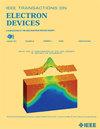单极和双极脉冲对hzo基效应场效应管泄漏和击穿的影响:提高耐用性的途径
IF 3.2
2区 工程技术
Q2 ENGINEERING, ELECTRICAL & ELECTRONIC
引用次数: 0
摘要
基于Hf0.5Zr0.5O2 (HZO)的铁电场效应晶体管(fefet)在非易失性存储器(NVM)应用中显示出巨大的前景,但其耐用性面临重大挑战,击穿是一个关键的限制因素。在本研究中,我们利用载流子分离方法研究了在不同的单极正、单极负和双极脉冲幅值下,fet的泄漏行为和击穿机制。我们发现每种脉冲类型的击穿机制不同:1)单极正脉冲驱动缺陷形成击穿路径(BD路径)而不是产生新的缺陷,并且随着BD路径的位置不同,击穿特征也不同;2)单极负脉冲抑制缺陷运动但产生新的缺陷,在SiO2界面层(IL)附近捕获正电荷,增加了HZO层处的电场,导致通道区域HZO层内形成初始BD路径;3)双极脉冲加速缺陷的产生,导致产生多个BD路径和击穿。基于这些发现,我们开发了一种使用单极负脉冲的回收方案,成功回收了100多次。控制缺陷的运动和产生是提高效应场效应管寿命的关键。本文章由计算机程序翻译,如有差异,请以英文原文为准。
Effects of Unipolar and Bipolar Pulses on Leakage and Breakdown in HZO-Based FeFETs: A Path to Improved Endurance
Hf0.5Zr0.5O2 (HZO)-based ferroelectric field effect transistors (FeFETs) show great promise for nonvolatile memory (NVM) applications, but their endurance faces major challenges, with breakdown being a key limiting factor. In this study, we investigated the leakage behavior and breakdown mechanisms of FeFETs under varying unipolar positive, unipolar negative, and bipolar pulse amplitudes using carrier separation method. We identified distinct breakdown mechanisms for each pulse type: 1) unipolar positive pulses drive defects to form a breakdown path (BD path) rather than the generation of new defects, in addition, the breakdown characteristics are different depending on the location of the BD path; 2) a unipolar negative pulse suppresses defects movement but generates new defects, and near the SiO2 interfacial layer (IL) traps positive charges, increasing the electric field at the HZO layer, which leads to the formation of the initial BD path in the HZO layer of the channel region; and 3) bipolar pulses accelerate defects generation, leading to the creation of multiple BD paths and breakdown. Based on these findings, we developed a recovery scheme using unipolar negative pulses, achieving over 100 successful recoveries. Controlling defects movement and generation is crucial for enhancing FeFETs endurance.
求助全文
通过发布文献求助,成功后即可免费获取论文全文。
去求助
来源期刊

IEEE Transactions on Electron Devices
工程技术-工程:电子与电气
CiteScore
5.80
自引率
16.10%
发文量
937
审稿时长
3.8 months
期刊介绍:
IEEE Transactions on Electron Devices publishes original and significant contributions relating to the theory, modeling, design, performance and reliability of electron and ion integrated circuit devices and interconnects, involving insulators, metals, organic materials, micro-plasmas, semiconductors, quantum-effect structures, vacuum devices, and emerging materials with applications in bioelectronics, biomedical electronics, computation, communications, displays, microelectromechanics, imaging, micro-actuators, nanoelectronics, optoelectronics, photovoltaics, power ICs and micro-sensors. Tutorial and review papers on these subjects are also published and occasional special issues appear to present a collection of papers which treat particular areas in more depth and breadth.
 求助内容:
求助内容: 应助结果提醒方式:
应助结果提醒方式:


